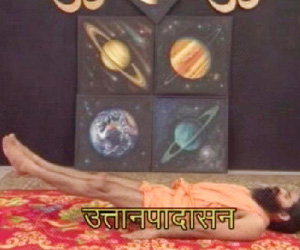Utthanpadasana | Raised Legs Pose
Uttan means raised and pada means feet in Sanskrit. It is also known as raised legs pose.
Procedure
1. Lie down with legs together, keep hands by the side of body and palms facing floor.
2. Now raise both legs to 30 degrees, while breathing in, do not jerk while lifting legs.
3. Hold your breath if not patient of high blood pressure as long as convenient.
4. Bring legs down while exhaling without bending knees.
5. Relax and do it three to six times.
Ardha-uttanpad asana means lifting one leg only and putting other on the floor. It’s procedure is same as above.
Duration
Raise the legs for ten to fifteen second. Do not practices for more than five times at a stretch. Do it in the morning and in the evening as well
Benefits
- Gives strength to all abdominal muscles.
- Strengthen thighs, waist, hips, back, spinal cord.
- Reduce stomach.
- Useful in constipation , wind trouble, and in indigestion.
Precautions
- Practice calmly because high pressure and stretching is felt on lower abdomen.
- Patient of spondylitis and muscle pull should avoid this asana.
- Patient of spinal injury must do it with one leg and don’t put undue strain on spine.
- Raise the legs slowly without putting extra pressure on mind or body.
